You can honor your grandmother's cherished recipes while adapting them for modern off-grid cooking methods. Start by identifying core ingredients that define the dish's authentic flavor, then adapt cooking techniques for solar ovens and sustainable tools. You'll need to double baking times and use dark cookware for ideal heat absorption when converting to solar cooking. Preserve moisture by reducing liquid content and keeping dishes covered. Traditional preservation methods like dehydration and fermentation help maintain your family's culinary heritage year-round. The journey of blending time-tested recipes with eco-friendly cooking practices opens up a whole new world of sustainable family traditions.
The Legacy of Grandma's Kitchen
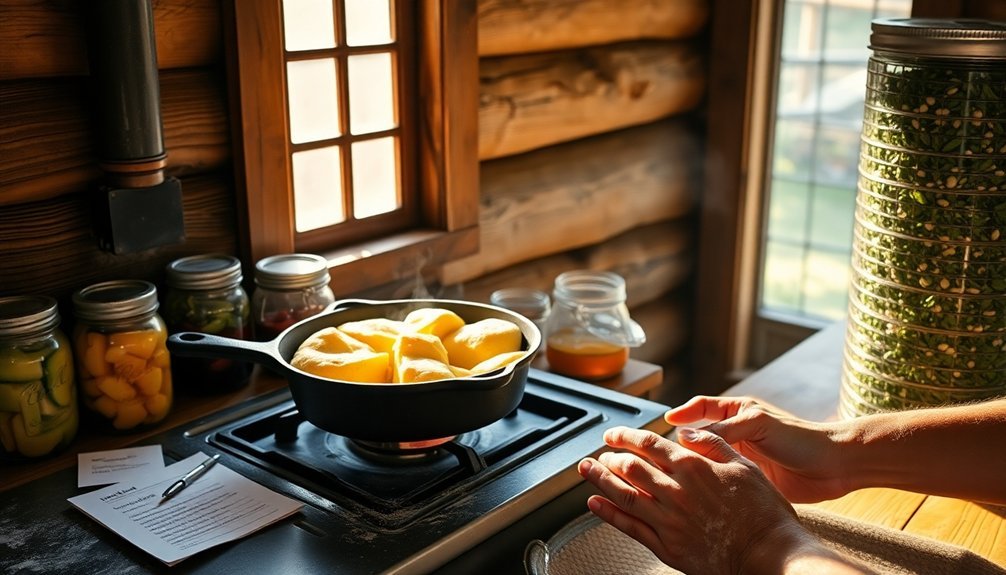
When you step into a grandmother's kitchen, you're walking into a living museum of family history where recipes serve as cherished artifacts. Each handwritten note, dog-eared magazine clipping, and stained recipe card tells a story of your family's journey through time.
You'll find these treasures carefully preserved in weathered recipe boxes or tucked between cookbook pages, representing generations of love and tradition. The familiar scents and tastes transport you back to holiday gatherings and Sunday dinners, where seasonal ingredients from the garden transformed into memorable meals. The evolution of traditional cooking has embraced modern kitchen technology while maintaining the authentic flavors of the past.
Through these recipes, you're not just recreating dishes; you're connecting with your ancestors' experiences. Every time you follow grandma's instructions, whether using her cast iron skillet or Dutch oven, you're keeping your family's legacy alive for future generations to cherish and continue.
Adapting Recipes for Solar Ovens
You'll need to double your usual baking times when converting Grandma's cherished recipes for solar oven use, as these eco-friendly cookers typically operate between 200°F and 300°F.
To maintain consistent temperatures, you should position your solar oven in full sunlight between 11 AM and 3 PM, rotating it regularly to follow the sun's path.
Keep your dishes moist by using tight-fitting lids and dark-colored cookware, which helps trap steam while maximizing heat absorption. Place newspapers for insulation around the edges of your solar oven to help maintain steady cooking temperatures.
Solar Baking Time Adjustments
Converting traditional recipes for solar oven use requires understanding key timing adjustments and temperature variations.
You'll need to expect longer cooking times since solar ovens typically operate between 250-350°F. While hot, sunny days might match conventional oven times, cooler conditions demand extra patience.
When adapting your family recipes, plan for fish fillets to cook in 45-75 minutes and pot roasts in 3-4 hours. Your baked goods like scones will take 1-2 hours, while bean dishes might need 6 hours or more. Starting with ingredients at room temperature will help ensure even baking, especially for cakes and cookies.
To optimize results, use dark-colored containers and position them in the oven's center. Remember to redirect your oven hourly to track the sun, and avoid opening the lid unnecessarily.
For best results, schedule your solar baking between 10am and 2pm when solar energy peaks.
Temperature Control Tips
Mastering temperature control in solar ovens starts with understanding their unique heating patterns. You'll need to adapt your recipes for temperatures between 160-200°F, which is lower than conventional ovens.
To optimize your cooking results, preheat your solar oven for at least 30 minutes and use a thermometer to monitor internal temperature. Using aluminum foil lining helps maintain consistent heat distribution throughout the cooking process.
When converting grandma's traditional recipes, choose dishes that work well at lower temperatures. You'll get better results if you reduce liquid content and cook foods in their natural state – like potatoes in skins or corn in husks.
Steam vegetables in dark-colored casseroles to maintain their color and nutrients. Remember to adjust your cooking times based on weather conditions, as sunny days around 85-90°F provide ideal cooking temperatures.
Keep the oven well-sealed and position it to capture maximum sunlight.
Moisture Retention Strategies
Building on proper temperature control, successful solar oven cooking hinges on effective moisture retention techniques.
You'll need to adapt your recipes by cutting liquid content in half, especially for cakes, as foods will cook in their natural juices. Use dark-colored cookware like black metal pans or dark brown glass dishes to maximize heat absorption and retention.
Keep foods covered with lids or clear plastic bags to trap moisture, and choose ingredients that naturally retain water, such as potatoes in their skins and corn in husks.
For best results, marinate meats beforehand and soak beans overnight. When cooking vegetables, use minimal water to prevent them from becoming soggy.
One-pot meals work exceptionally well, as all ingredients cook together, maintaining consistent moisture levels throughout the cooking process.
Essential Solar Cooking Equipment
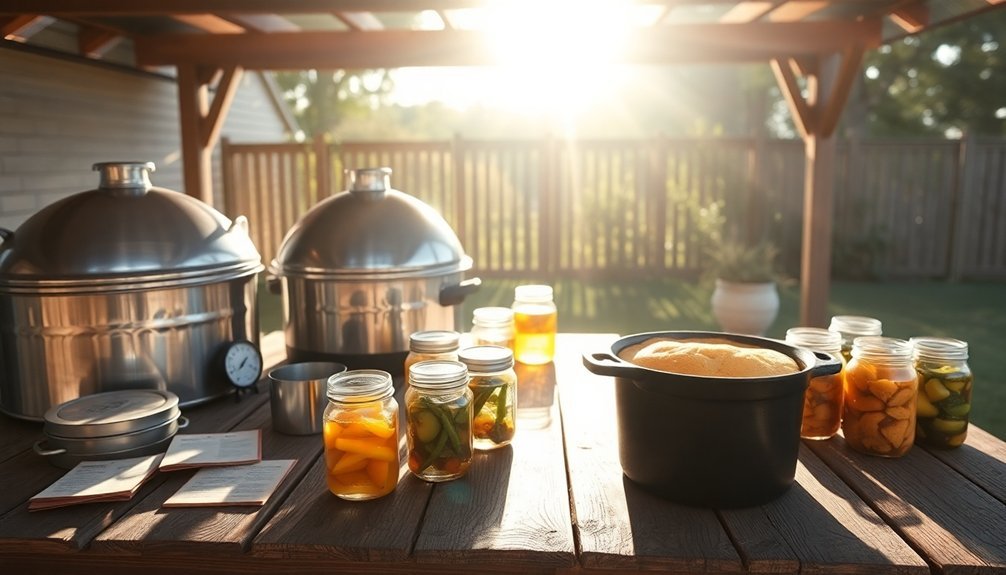
Every successful solar cooking journey begins with the right equipment.
You'll need reflective surfaces like aluminum foil or mirrors to direct sunlight, and dark-colored pots that efficiently absorb solar radiation. Don't forget essential insulation materials – newspapers and cardboard work well to maintain cooking temperatures.
For the main cooker, you've got several options. Box cookers are great for beginners, reaching 200-300°F and requiring minimal adjustment.
If you're ambitious, parabolic cookers can hit 400°F but need frequent repositioning. Panel cookers offer a middle ground, perfect for slow-cooking grandma's stews.
Consider starting with a box cooker – it's forgiving, reliable, and ideal for preserving traditional recipes. Just add a clear plastic wrap or tape to create that vital greenhouse effect for heat retention.
From Cast Iron to Solar
Your grandmother's cherished cast iron cookware meets modern solar cooking methods to create a perfect blend of old and new.
You'll find that traditional cast iron's durability and heat retention work beautifully alongside solar cooking equipment, offering you versatile options for off-grid meal preparation.
While your grandmother might've cooked exclusively with cast iron, you can now combine these time-tested tools with solar technology to maintain her cooking traditions while embracing sustainable practices.
Traditional Techniques Meet Technology
While traditional cooking methods have stood the test of time, modern technology has revolutionized how we approach these time-honored techniques.
You'll find that slow cooking and steaming methods now merge seamlessly with solar ovens and contemporary kitchen tools, preserving nutrients while enhancing flavors naturally.
You can adapt your grandmother's recipes using various solar cooker types, from panel to parabolic models, each offering unique benefits for off-grid cooking.
These modern adaptations don't compromise the essence of traditional techniques – they enhance them.
Whether you're reducing sauces or emulsifying dressings, today's tools make it easier to achieve authentic results.
Cast Iron's Timeless Appeal
Among kitchen heirlooms passed down through generations, cast iron cookware stands as a tribute to enduring craftsmanship.
You'll discover that with proper care, these versatile pieces can serve your family for decades, evolving seamlessly from stovetop to oven while maintaining consistent heat distribution.
Unlike modern cookware, cast iron's reliability shines in both traditional and off-grid cooking scenarios.
You won't need to worry about power sources – your cast iron performs equally well over a campfire or modern stovetop.
- A well-seasoned cast iron skillet becomes naturally nonstick, eliminating the need for chemical coatings
- Its superior heat retention makes it perfect for both quick sears and slow-cooked meals
- The durability means you'll never need to replace it, making it a sustainable choice for eco-conscious cooks
Time-Tested Family Meal Conversions
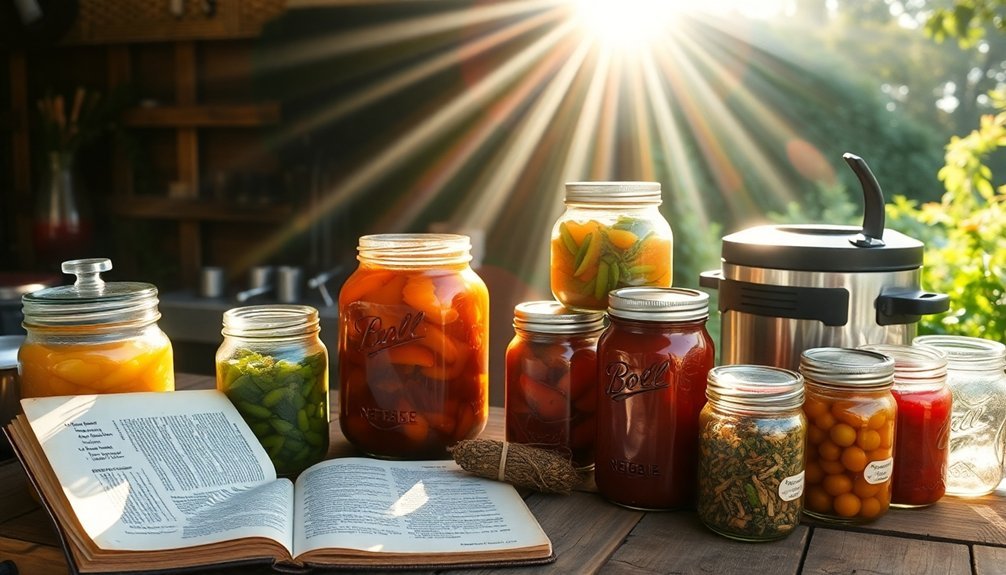
Converting cherished family recipes for modern kitchens doesn't mean sacrificing the heart and soul of traditional cooking. You'll find that modern tools like the Instant Pot or air fryer can actually enhance your family's favorites while preserving their authentic flavors.
Start by identifying the core ingredients that make your recipe special, then consider how you can streamline the preparation using today's techniques.
For example, you can transform Grandma's time-consuming Wiener schnitzel by using quinoa instead of breadcrumbs and serving it with a fresh arugula salad.
Document your adaptations carefully, noting which substitutions work best and how cooking times differ with modern appliances.
Remember to maintain the essential flavors while making adjustments that suit your family's dietary needs and taste preferences.
Seasonal Solar Recipe Planning
Since seasonal produce and sunlight patterns change throughout the year, successful solar cooking requires thoughtful planning and adaptation.
You'll find that matching your recipes to both available ingredients and ideal cooking times creates the most rewarding results.
During peak hours between 11:00 am and 3:00 pm, your solar oven becomes a versatile tool for transforming seasonal bounty into delicious meals.
Choose your cooking method based on the recipe:
- Use panel ovens for gentle cooking of spring greens and tender summer vegetables
- Select box-type ovens for hearty fall squashes and root vegetable casseroles
- Opt for parabolic or tubular ovens when you need higher temperatures for browning winter dishes
Adapt traditional family recipes by breaking down cooking steps across multiple days, especially during seasons with shorter daylight hours.
Preserving Traditional Flavors Off-Grid

Traditional flavors can be preserved even without modern amenities through time-tested preservation methods.
You'll find dehydration particularly useful for maintaining your family recipes, as it's both cost-effective and efficient for preserving fruits, vegetables, and meats while keeping their essential nutrients intact.
Fermentation and pickling offer you ways to enhance flavors while extending shelf life. You can transform ordinary vegetables into probiotic-rich delicacies using these techniques, just as your grandmother did.
For heartier dishes, you'll want to master pressure canning and water bath methods to safely preserve your homemade soups and stews.
Don't overlook specialized techniques like smoking, curing, or water glassing – they're invaluable for preserving meats, fish, and even fresh eggs without electricity.
These methods guarantee you'll keep your traditional recipes alive while living off-grid.
Solar Baking Tips and Techniques
Solar baking lets you harness the sun's energy to create delicious home-cooked meals while preserving your family's culinary traditions.
You'll need dark-colored cookware, like affordable Granite Ware, to efficiently absorb sunlight. For ideal results, pre-heat your solar oven for 15-20 minutes and keep it facing directly toward the sun.
To successfully adapt traditional recipes for solar baking, remember these essential tips:
- Monitor internal temperature with a thermometer, ensuring it reaches at least 180°F for meat dishes
- Use smaller containers and lidded baking dishes for even cooking and moisture retention
- Expect longer cooking times, especially for browning and crisping, as temperatures typically range from 250-350°F
Most conventional recipes work well in a solar oven, from lasagna to cookies, though you'll need to adjust cooking times based on weather conditions and sun exposure.
Modern Methods Meet Heritage Cooking
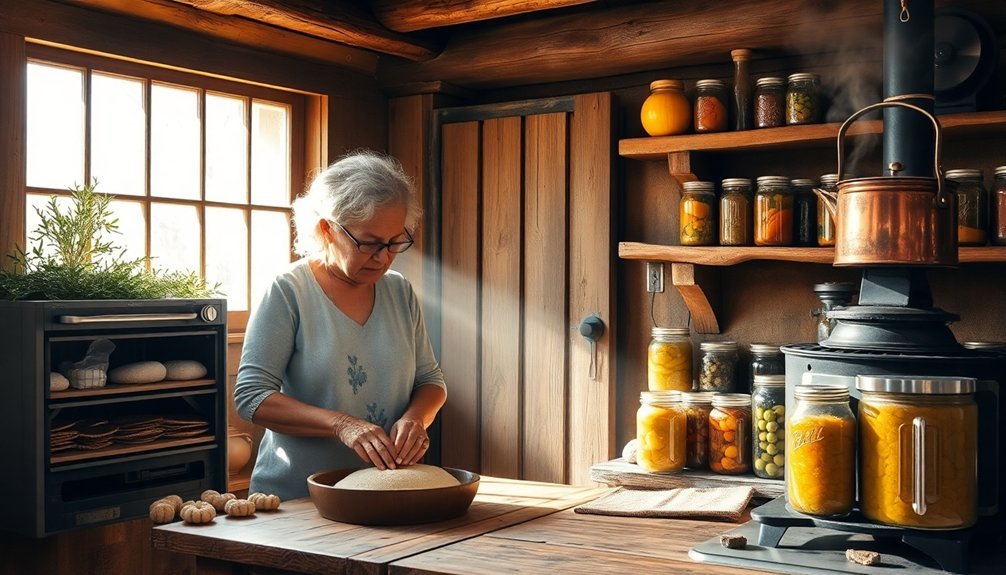
While solar cooking offers one path to sustainable food preparation, blending time-honored cooking methods with modern innovations opens up exciting new possibilities for off-grid heritage cooking.
You'll find that traditional open-fire and Dutch oven techniques now pair beautifully with contemporary ingredients like truffle oil and preserved lemon.
You can transform your grandmother's recipes by incorporating fusion elements, such as adding harissa to pizzas or creating kimchi tacos.
Try lightening up classic dishes with quinoa or gluten-free alternatives while maintaining their authentic essence.
Don't forget to document these adaptations for future generations – it's about preserving culinary heritage while embracing change.
Whether you're using freekeh in a modern grain bowl or smoking paprika in traditional stews, you're participating in the evolution of heritage cooking.
Frequently Asked Questions
How Do You Adjust Spice Levels When Cooking With Solar Ovens?
Start with less spices than usual since solar ovens enhance flavors during slow cooking. You'll want to taste and adjust periodically, but remember that you can't easily add more once the dish is done.
Can Traditional Fermentation Recipes Work in Off-Grid Cooking Methods?
Yes, you'll find traditional fermentation recipes work perfectly off-grid. They don't need electricity or modern equipment. Just keep your vegetables submerged in brine, maintain proper temperature, and monitor regularly for best results.
What Altitude Adjustments Are Needed for Solar Oven Cooking Times?
You'll need to increase cooking times by 25-30% at high altitudes. Keep food covered to prevent moisture loss, add extra liquid, and maintain consistent temperature by adjusting your solar oven's angle throughout cooking.
How Do Regional Weather Patterns Affect Solar Cooking Success Rates?
You'll find your solar cooking success depends heavily on clear skies and strong sunlight. Cloudy, rainy, or dusty conditions reduce efficiency, while regions with consistent sunny weather between 11am-3pm offer the best results.
Which Traditional Recipes Should Never Be Attempted With Solar Cooking?
You shouldn't attempt recipes requiring precise temperature control like soufflés, deep-fried foods, or quick-sear meats. Also avoid delicate pastries, temperature-sensitive custards, and dishes needing rapid heat changes for safety.
In Summary
You've taken your grandmother's cherished recipes and transformed them for modern off-grid living without losing their heart and soul. By adapting these traditional dishes for solar cooking, you're carrying forward a legacy while embracing sustainable practices. Whether you're baking bread in a solar oven or slow-cooking stews using the sun's energy, you're keeping family traditions alive while pioneering eco-friendly cooking methods for future generations.



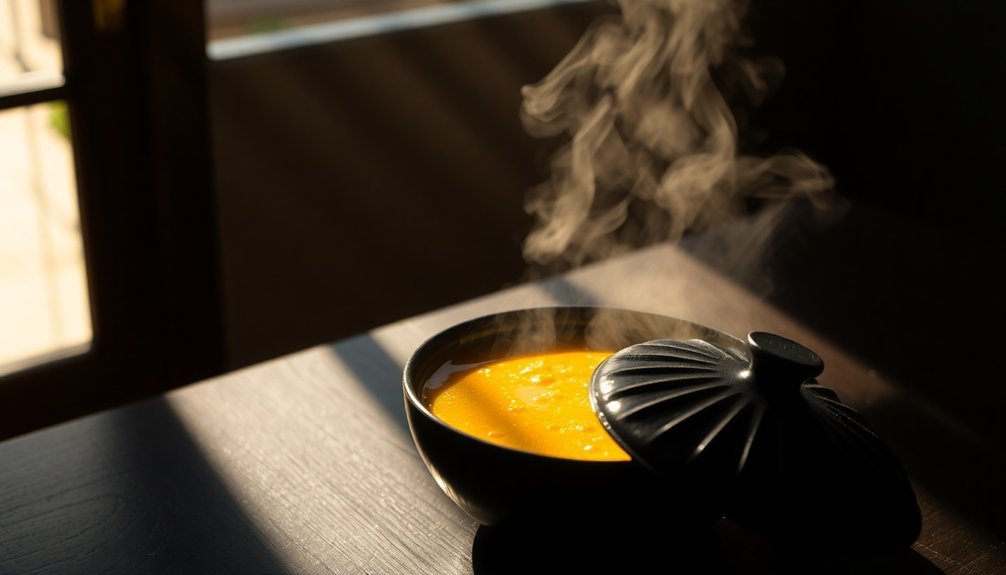
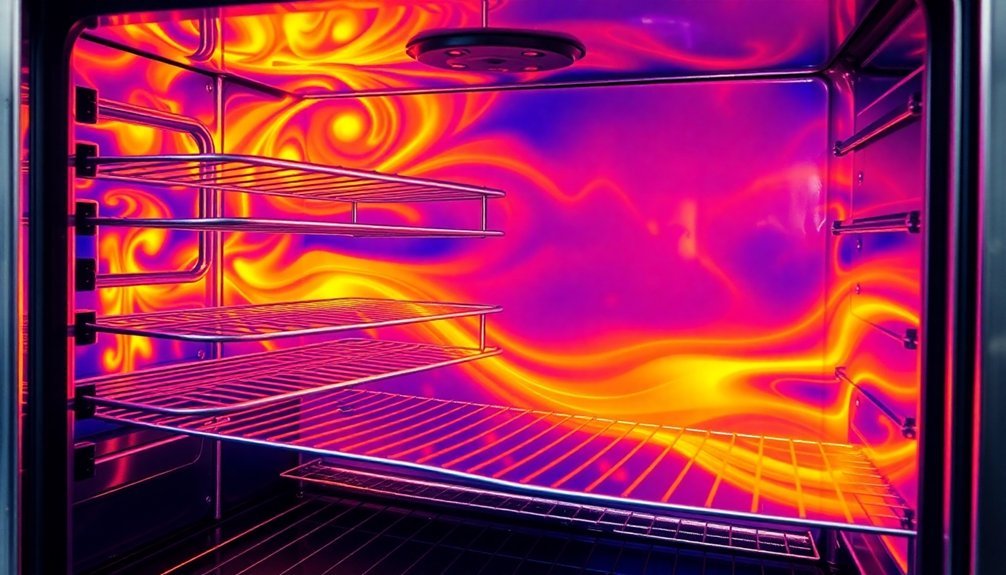
Leave a Reply